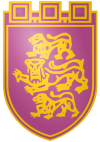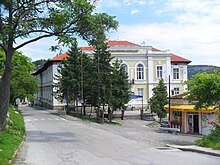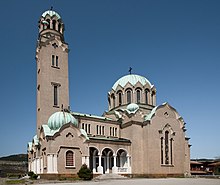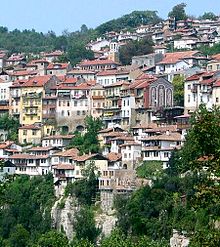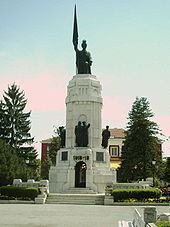Veliko Tarnovo
| Veliko Tarnovo (Велико Търново) | ||||
|
||||
| Basic data | ||||
|---|---|---|---|---|
| State : |
|
|||
| Oblast : | Veliko Tarnovo | |||
| Residents : | 68,478 (December 31, 2016) | |||
| Area : | 30 km² | |||
| Population density | 2,282.6 inhabitants / km² | |||
| Coordinates : | 43 ° 5 ' N , 25 ° 39' E | |||
| Height : | 325 m | |||
| Postal code : | 5000 | |||
| Telephone code : | (+359) 062 | |||
| License plate : | BT | |||
| administration | ||||
| Mayor : | Rumen Rashev | |||
| Website : | www.veliko-tarnovo.net | |||
Veliko Tarnovo or Tarnovo [ vɛˈliko ˈtɤrnovo ] ( Bulgarian Велико Търново , also: Veliko Tarnovo ), more rarely Tirnovo is a town in Bulgaria with around 68,000 inhabitants (as of December 31, 2016). It is the administrative seat of the oblast (district) of the same name and the municipality of Veliko Tarnowo . The regional center is located in the northern part of the Balkan Mountains on the Jantra . Veliko Tarnovo was the capital of the Second Bulgarian Empire . The city is an important traffic junction on the Bulgarian north-south route; it has the Gorna Oryakhovitsa airport ; it has the characteristics of an industrial city (food and luxury goods, mechanical engineering, textile industry), but is also a cultural center with universities, theaters, picture galleries and museums.
geography
Tarnowo is located on the steep northern slopes of the Balkan Mountains, where the Jantra River has carved a deep, meandering gorge through the rock. The river erosion resulted in several larger hills such as the Tsarevets , the Trapesiza or the Sweta Gora (German: holy mountain). The first small fortress was built on the Tsarevets , around which the present-day town developed over the centuries.
Neighboring towns of Veliko Tarnowo are: Gorna Orjachowiza , Levski , Swishtov , Bjala , Razgrad , Popowo , Targovishte , Kotel , Sliven , Nowa Sagora , Stara Sagora , Kazanlak , Gabrovo , Trojan .
history
The name of the city changed in the different epochs from Tarnowo, Tarnowgrad via Tarnowo (until 1965) to Veliko Tarnowo, which means great or glorious Tarnowo in Bulgarian . The name goes back to the history of the city in the Middle Ages, when Tarnowo was the capital of the Bulgarian Empire.
prehistory
Early traces of settlement in the area of today's city date from the Bronze Age ( 13th century BC ); they were found on Tsarevets Hill. Bronze Age traces have also been found on the Trapesiza hill. There are archaeological sites in the area from Thracian times.
Antiquity
During the Roman times (1st to 6th century AD) the place was fortified. The Romans were followed by the Byzantines , and later Slavs settled the area.
middle Ages
In 1185 Tarnowo (also called Tarnowgrad) entered history when the two Boljar sons and later Tsars Assen and Peter called on the Bulgarian people to fight against Byzantium in the Sweti-Georgi Church. The uprising lasted two years and ended with the independence of Northeast Bulgaria and its recognition by Byzantium. Veliko Tarnowo became the fourth capital of the Bulgarian Empire after Pliska , Veliki Preslav and Ohrid from 1187 to 1393 and experienced a heyday in the 13th and 14th centuries.
Even before the establishment of the Second Bulgarian Empire, there was a castle of the feudal rulers Petar and Ivan Assen on the Tsarevets hill. The Tsar's Castle developed from this complex in the following decades. In the 13th and 14th centuries, the inner city expanded to three fortified hills - Tsarevets (the mountain of the Tsars), Trapesiza and Sweta Gora - and new outskirts emerged on the Momina Krepost (women's fortress ). New city quarters such as the Assenenviertel, the Jewish quarter or the Franconian quarter also emerged between the hill plateaus in the Jantratal. The city developed into the political, religious and cultural center of the Bulgarian feudal state.
The most important place in Tarnowgrad was the hill Tsarevets . The state administration was concentrated in the fortress. The fortress had a complicated fortification system and inside there were craft and residential areas, churches and monasteries. The representative palaces of the Tsar and the Patriarch were built on the highest part of the plateau. On the neighboring hill Trapesiza were the magnificent possessions of the Boljars (aristocrats). More monasteries and churches were built on the Sweta Gora hill plateau , which became the spiritual and cultural center of the Bulgarian state. In the largest of them, the Monastery of the Mother of God ( Sweta Bogorodiza Odigitria ), the Tarnovo School of Scholars and Painting School developed a lively activity. Today the University of Cyril and Methodius stands on the former site of the monastery .
Little by little the Bulgarian tsars managed to overcome the feudal fragmentation of the country. Ivan Assen II recaptured Macedonia , Thrace and other areas for the Bulgarian Empire, so that by the middle of the 13th century it was again the largest state on the Balkan Peninsula . The political and military strength of Bulgaria was culturally consolidated through the construction of numerous churches, monasteries and palaces. Tarnowo was one of the most important pilgrimage sites on the Balkan Peninsula in the Middle Ages. Numerous relics of saints, including those of Sava of Serbia , Demetrios of Thessaloniki and Ivan Rilski , are buried here. The era of Ivan Assen II, also known as the Golden Age , was followed by a period of internal tension and unrest.
When a great peasant uprising broke out in 1277, the residents of Veliko Tarnovo opened the gates of the capital to the peasant leader Ivajlo in spring 1278 and crowned him tsar. During the Tatar storms in the following period, the population of the area escaped several times behind the thick fortress walls of Tarnovo. Under Tsar Ivan Alexander , the Bulgarian Empire and the Tarnowo Art School reached their last glorious days. The great Bulgarians of the Middle Ages worked here, the Patriarch Eftimij , Theodosios von Tarnowo , the monks Kiprian , Grigory Camblak and Konstantin Kostenezki (who also brought the literary achievements of Bulgarian literature to Serbia and Russia ). There they represented the foundation of literary development, so that one can speak of a second South Slavic influence on the Ukraine and Russia.
In the Ottoman Empire
Continuing internal political controversies and clashes with Serbia ultimately led to such a weakening of the empire that the troops of the Ottoman Empire were able to capture and destroy Veliko Tarnovo in July 1393 despite resistance after a three-month siege. Part of the population, including the dignitaries, was massacred, another was forcibly evacuated (sürgün).
Tirnowo, as the conquerors called the city, became the center of a Kaaza (municipality) with a majority Muslim population as a small town . The Kaaza was in Sandzak incorporated administratively Nikopol. The preserved churches were converted into mosques and horse stables by the new rulers. Thus the Church of the Holy Forty Martyrs became Kawak Baba Tekke . It took decades for the city to recover. Ottoman tax registers ( Defter ) from the 15th and 16th centuries give the population around 4600, a third of whom were Muslims. It was not until the late Ottoman period that the city began to play an important role again.

The city remained a source of unrest, however, and attempts to revolt were constantly being made from here, the first in 1598 (first Tarnowo uprising). The Second Tarnovo Uprising took place under the leadership of the Prince of Tarnovo, Rostislav Stratimirovich , but was like the following (Tarnovo Uprising of 1700, the Weltschower Uprising of 1835, the rising of Captain Djado Nikola (1856), the Haji Stavrew Uprising in 1862) unsuccessful. At the end of the 18th century there were 11 churches and 3 monasteries in the city.
During the Bulgarian rebirth and in the course of the struggle for an autocephalous Bulgarian church, an uprising against the Greek bishop Philaret broke out in Tarnowo in 1838 . The architecture of the old town is still characterized by buildings from this period.
In 1864, after the founding of the province of Vilayet Tuna , Tirnowa became the center of a sanjak . According to the official yearbook of the Ottoman government of 1872, there were 22 mosques in the city.
During the April uprising of 1876, Veliko Tarnovo became the center of the "First Revolutionary Region of Tarnovo". This revolutionary region comprised the areas around Veliko Tarnovo, Gorna Oryachowitsa , Sevlievo , Gabrovo and Trojan . The main responsible was the apostle and later Prime Minister Stefan Stambolow together with Christo Karaminkow-Bunito and Georgi Izmirliew-the Macedonian, as deputies. After the bloody crackdown, the revolutionaries Batscho Kiro , Zanko Djustabanow and many other freedom fighters were hanged in the city center .
At that time there were 1,008 shops, 9 hane (caravanserais) and 3 bathhouses ( hamams ) in Tirnowa .
Veliko Tarnowo was liberated by the Russian army on July 7, 1878 in the course of the Russo-Turkish War of 1877/78 .
In independent Bulgaria
From February 10 to April 16, 1879, the Tarnovo constitution , the first democratic constitution for Bulgaria, was drawn up in the city . On April 17, 1879, the country's First Great Legislative Assembly was constituted in the city to elect a head of state. On July 27, 1879, Alexander von Battenberg was proclaimed Prince of Bulgaria here.
As a reaction to the decisions of the Berlin Congress (1878), the first "Edinstvo" ( Единство / unit) committee was founded in Veliko Tarnovo by Stefan Stambolow, among others . The committees had set themselves the goal of revising these decisions by Berlin and " restoring Bulgaria within its national borders from the peace of San Stefano ". One of their first acts was the preparation and implementation of the Kresna-Raslog uprising (1878).
While Tirnowa still had about 5000 inhabitants in the middle of the 17th century, it was about 12,000 in the middle of the 19th century; In 1900, 11,628 of these were Bulgarians, 748 Turks, 52 Armenians and 23 Roma and Sinthi. In 1976 the city had 58,096 inhabitants.
| year | 1878 | 1900 | 1959 | 2001 | 2003 | 2007 | 2014 |
|---|---|---|---|---|---|---|---|
| Residents | 5,700 | 12,000 | 25,170 | 66,998 | 67,000 | 71,275 | 73,406 |
Economy and Infrastructure
In the 1860s, the first production facilities for silk , alcohol , paper and soap were established in Tarnowo . The resulting brisk trade in goods and viticulture played an important role. In the 20th century Tarnowo had already grown into an influential industrial city, leather goods, textiles and food were produced. Viticulture and silkworm breeding continued. The brewing, meat production, mill products including pasta production were also economically important.
transport
- Veliko Tarnovo station (built in 1900)
- Veliko Tarnovo bus station (built in 1950)
Education, culture and sport
Veliko Tarnowo was the cradle of many important schools in literature, architecture and painting. Particularly noteworthy is the art school of the 19th century, which had a great influence on the style epoch of the national rebirth .
Today there is the St. Cyril and Method University in the city with a wide range of subjects. In addition, the address book lists the military university Wassil Lewski , a pedagogical college, 18 high schools and two pedagogical schools, and finally a technical school each for economics, medicine and construction.
The following cultural institutions are available to residents and tourists:
- State Drama Theater Konstantin Kissimow
- Amateur opera
- Operetta theater
- Open-air theater in Tolbuchin Park
- Symphony orchestra
- numerous dance and singing ensembles
- Picture gallery
- District Museum and
- the Petko Slavicov library
- a sports stadium with 15,000 seats.
The city has a total of 15 museums.
Sights and buildings
Because of the special location on the rocky steep bank and in the hinterland of the Jantra River , because of the historical traditions and the architectural monuments, Veliko Tarnowo is also a preferred tourist destination. While the current development of the old town with its single-family and terraced houses mainly dates back to the time of the Bulgarian Revival, more modern buildings can be found in the outskirts. The most famous Bulgarian architect of the time, Kolju Fitscheto , also worked here.
Churches
The following are selected from a total of 18 houses of worship:
- Dimitar Solunski Church
- also called the Tsar's Church because the Bulgarian rulers Assen, Petar and Kalojan were crowned here
- Peter and Paul Church (bulg. Свети Петар и Павел)
- Well-preserved architectural testimony from the Tarnowgrad 13th / 14th centuries. century
- Saints Constantine and Elena Church (bulg. Свети Константин и Елена)
- according to plans of the builder Kolju Fitscheto
- Sweti-Georgi-Kirche (bulg. Свети Георги)
- Sweti Dimitar Church (bulg. Свети Димитър)
- The church was built in 1185 and named after Saint Demetrios of Thessaloniki . For a time, during the reign of Ivan Assen II, the relics of Thessaloniki were kept here. The church is a single-nave domed structure with a W-tower over the vaulted narthex . The outer facades and the tambour are structured by blind arches. The masonry is decorated with ceramic incrustations using a mixed technique . In addition, the church was painted with frescoes in the 12th and 16th centuries . In 1913 an earthquake destroyed the church except for the eastern part, but was rebuilt in 1981.
- Sweta Petka Church (Palace Church)
- Monastery Complex of the Holy Forty Martyrs (bulg. Свети 40 Мъченици)
- The monastery complex was built in the 13th century south of the Tsarevets on the right bank of the Jantra. As early as the 14th century, after the fall of Bulgaria under Ottoman-Turkish rule, it was destroyed and a little later converted into a mosque with a dervish monastery. The complex of the Great Lavra of Tarnowo , which has not yet been fully excavated and researched, contained, in addition to several monastery buildings, the Katholikon (the main church), a three-aisled pillar basilica (which is now called the Holy Forty Martyrs ). The basilica was built in 1230 and a little later, following the narthex, another building, which served as an additional room or mausoleum, was added. The interior of the church is dominated by the memorial columns for Khan Omurtag and Tsar Ivan Assen II. Few remains of the original painting from the founding period have been preserved in the narthex. In recent years, some fragments of the painting of the W building (mid-13th century), which belongs to the picturesque style of the Tarnowo Art School , have been exposed .
- Tsarina Anna Maria of Hungary and Irene Angelos Komnene , both wives of Ivan Assen II, Saint Sava of Serbia , and many other members of the Tsarist families were buried in the Basilica of the Holy Forty Martyrs . In 2007, the remains of Tsars Kalojan and Michail III found during excavations . Schischman added.
- There are also numerous medieval monasteries in the vicinity of the city, some of which have been rebuilt. These include the Preobraschenie (Transfiguration of the Lord), Kilifarewo , Sweta Troica (Holy Trinity) monastery and the numerous monasteries and churches in the village of Arbanasi .

Secular buildings
- Building on the Tsarevets -Hügel
- Fortress as ruins with restored fortress wall and impressive entrance gate, uncovered in 1945
- Palace of the Bulgarian Patriarch, which rises high above the Tsar's Palace. The built-up area is 3000 m². The center is dominated by the Assumption Church ( Vasnesenie Gospodne ) with a bell tower, which is seldom found in sacred buildings in the Balkans.
- the city prison
- Residential houses in the old town with narrow streets, notably including the Sarafkina-Haus (House of the Money Changer )
- a Turkish residence (so-called Konak ) from 1872
The modern Stambolowija Bridge high above the river is spectacular . The Interhotel from 1981 is a striking building of Eastern European brutalism .
27 human monuments can be found all over Tarnowo.
Personalities
sons and daughters of the town
- St. Patriarch Euthymios of Tarnowo (~ 1325– ~ 1403), Patriarch of the Bulgarian Orthodox Church
- Grigorij Camblak (~ 1364–1450), Metropolitan of Kiev and Lithuania
- Rostislaw Stratimirowitsch (17th / 18th century), Prince
- Sawa Mutkurow (1852-1891), General
- Stefan Stambolow (1854–1895), Prime Minister
- Ivan Fitschew (1860-1931), General
- Wassil Slatarski (1866–1935), archaeologist and historian
- Konstantin Kisimow (1897–1965), actor
- Emilijan Stanew (1907–1979), writer
- Spas Wenkoff (1928–2013), Bulgarian-Austrian opera singer
- Nikolaj Ovtscharow (* 1957), archaeologist and historian
- Krassimira Stojanowa (* 1962), opera singer
- Nikolaj Nenowski (* 1963), economist
- Wessela Letschewa (* 1964), sports shooter and politician
- Krassimir Balakow (* 1966), football player and coach
- Iwajlo Kossakow (* 1977), clergyman and theologian, titular bishop of Agathopol and vicar of the Metropolitan of Sliven
- Stanislaw Gentschew (* 1981), football player
- Kotoōshū Katsunori (* 1983), sumo wrestler in Japan
- Radoslawa Slavcheva (* 1984), soccer player
- Tinko Banabakow (* 1994), boxer
Twin cities
Veliko Tarnovo maintains the following twenty cities, a partnership :
| city | country | since |
|---|---|---|
| Asti |
|
1989 |
| Bayonne |
|
2005 |
| Bitola |
|
2006 |
| Cetinje |
|
2006 |
| Colonia Tovar |
|
1992 |
| Golden |
|
2000 |
| Iași |
|
2006 |
| Kerak |
|
2009 |
| Krakow |
|
1975 |
| Menara, Marrakech |
|
2001 |
| Niš |
|
1973 |
| Ohrid |
|
1998 |
| Poltava |
|
1963 |
| Serres |
|
1988 |
| Sopron |
|
2002 |
| Tarxien |
|
2007 |
| Toledo |
|
1983 |
| Tver |
|
1997 |
| Xi'an |
|
2006 |
| Zadar |
|
2008 |
gallery
literature
- Reinhardt Hootz: Art Monuments in Bulgaria. A picture handbook , Deutscher Kunstverlag Munich, 1983, ISBN 3-422-00383-5
- Prof. Nikolaj Ovtscharow : Tarnovgrad - the second cosmopolitan city after Constantinople in the history of Bulgaria. Brief overview , Lettera Verlag, Plovdiv, 2006, ISBN 954-516-584-7 .
- Article Tirnowa in Encyclopaedia of Islam , Volume X, page 547, column 1.
Individual evidence
- ↑ a b c Tarnovo on Zone Bulgaria, accessed February 14, 2010
- ↑ Tirnowa in Encyclopaedia of Islam, Volume X, page 547, column 1: … In 795/1393 it was besieged and captured by the Ottomans, with severe reprisals against the town; the Tsar's palace and the fortress walls were demolished, the Bulgarian Patriarch exiled and many local dignitaries executed… , … After the Ottoman conquest, part of the population was massacred and others subjected to forced deportation (sürgün). ...
- ^ Encyclopaedia of Islam, Volume X, page 547, column 1
- ↑ a b c Meyers Neues Lexikon , Bibliographisches Institut Leipzig, 1963, Volume 7, p. 952
- ^ EW statistics, as of 2001 ( Memento from February 20, 2010 in the Internet Archive )
- ↑ University homepage (Bulgarian / English)
- ↑ a b Flyer: Veliko Tarnovo , Balkantourist (Ed.), 1968
- ^ 'Zone Bulgaria' with a representation of the sights in Tarnovo
- ↑ Representation of the twin cities in 'Infotourist' (Bulgarian) ( Memento from November 22, 2007 in the Internet Archive )
- ↑ Градове - партньори. Retrieved December 6, 2016 .
